Perhaps against all odds, Ralph Bakshi’s recent success in getting his latest project funded via Kickstarter attests, if not to his current relevancy, then at least to his tenacity. Working in a medium monopolized by Disney and its copycats, Bakshi has been a figure in the American animation scene for decades, producing controversial, if not altogether attractive, animated films that have on occasion gone head to head with the Big Mouse itself. Throughout his career, Bakshi has never tried to make films that are palatable; his breakthrough film, Fritz the Cat, was the first X-rated animated film to get a wide release and was described by no less than Underground Comix grandfather R. Crumb as “repressed”, “fascistic” and “twisted in some kind of weird, unfunny way.” As if trying to live up to such harsh criticism, Bakshi’s films are often raw, angry creations, full of a manic energy that ambles frantically from acerbic subversion to a desultory, formless racism and misogyny that would drive away nearly anyone within the first half hour. Bakshi, especially in his earlier films, works from a paradigm of art popular during the 60s and 70s in the Underground Comix scene which states that anything that makes your mother and government cringe is gold, a philosophy that validates all manner of perversion and political protest as well as any racism, misogyny, or homophobia that happens to creep up on part of the part of the usually white, straight and male artist. Despite, or perhaps because of, the frantic and vitriolic nature of his work, Bakshi remains one of the only artists who has ever locked horns with the animation industry and come out clean; with Fritz and the subsequent film Heavy Traffic, Bakshi became the first animator since Disney to produce two back to back commercially successfully films. But alongside his penchant for controversy and money making ability, Bakshi had, and perhaps still has, something exceedingly rare in the world of American animation; a political drive, an ideology, a statement he wanted to shove in the face of The Man with nothing but his cartoons.
The paradox of Bakshi lies in the disparity between the movement of his work and its actual content; even taking his greatest failings into account, his impact on animation as an artistic medium in the United States cannot be questioned. Taking inspiration from the Underground Comix movement of the time, Bakshi suggested that animation, like any medium of expression, had a social obligation to rearticulate complex social and political issues in new and subversive ways, a line of thought far removed from either mainstream Disney logic or the more mischievous ideology embodied in its counterparts, Warner Bros, Hannah-Barbera, and currently Dreamworks. Speaking to the Los Angeles Times in 1971, a year before Fritz was released, he famously said “The idea of grown men sitting in cubicles drawing butterflies floating over a field of flowers, while American planes are dropping bombs in Vietnam and kids are marching in the streets, is ludicrous.” Alongside this, Bakshi’s animation studio, Bakshi Productions, gave unprecedented opportunities to female and PoC animators at a time when they were virtually nonexistent in the industry. In this respect, Bakshi is unique. Even as animation has matured in the Umited States, developing if not a sense of moral obligation than at least a sly self-awareness, no past or contemporary animator has made a claim as bold nor attempted to follow through on it as Bakshi has.
This drive, towards a redefinition of animation and a shifting of its central paradigms, constitutes the movement of Bakshi’s oeuvre; the content of it, however, falls significantly short. Bakshi once said R. Crumb hated his adaptation of Fritz the Cat because of the added social commentary; Crumb himself said it was because the film was “repressed” and “fascistic”, especially when its climax ended as a condemnation of the radical left. Among the highlights of Fritz are graphic cartoon rape, the depiction of African-Americans as lusty, atavistic crows who only gain a modicum of revolutionary spirit when Fritz wills it into them and an endless parade of women as nags, sex toys and brainless groupies that would make Jack Kerouac uncomfortable. Fritz delights in sex — angry, ubiquitous and in your face sex that feels less revolutionary than it does a big middle finger to mom and dad. That isn’t to say that sexuality shouldn’t have a place at the table, or even that it shouldn’t make the viewer uncomfortable, but watching the endless repetition of cartoon humping carries all the pointed commentary of a Bansky cartoon where the villain is a McDonalds logo wearing a Mickey Mouse hat and carting an M16 Carbine. An idea is present, perhaps, but its execution is so muddled and caught up in its own cleverness it might as well start railing about “the man.” And the main character, Fritz, is a walking, humping manifestation of everything bad on a college campus; a navel-gazing, whiny, misogynistic pseudo-philosopher whose endless drive for “meaning” in a cruel and empty world where he occasionally has to go to classes and gets rejected for sex is supposed to make him a sympathetic character in the viewers’ eyes. Had the movie, perhaps, decided to cast Fritz as a completely unsympathetic character, someone who plainly isn’t fit to run a lemonade stand, let alone a revolution, the tone of the film would be different and its content more palatable. As it stands, however, Fritz remains an almost unwatchable film, and not for the reasons either Bakshi or his right-wing critics would attest.
After the tempest that was Fritz the Cat (and box office success, in no small part due to its notoriety) Bakshi’s films seemed turned towards the personal rather than the heavy-handedly political. Heavy Traffic, the film immediately succeeding Fritz the Cat, sought to latch on to the latter’s momentum in what Michael Barrier described in his seminal Hollywood Cartoons as an effort “to push beyond what was done in the old cartoons, even while building on their strengths.” Bakshi, a Palestinian native who grew up in working-class Brooklyn digging through the trash for comics, used the film to channel an aesthetic vision of American urbanity at once instantly recognizable and deeply personal; an America dominated by pinball machines, wafting cigarette smoke, one-word ethnic caricatures and, in the words of the trailer, an amalgamation of “hoods, hustlers, freaks, creeps, cops, crazies, weirdos, rhinos, hardhats, lowlives,” and most interestingly, “god.”
The Brooklyn Heavy Traffic shows us is one of juxtaposed creations; diseased streets filled with tender hearts, crude ethnic caricatures concealing complex interpersonal relationships, slapstick violence masquerading the very real blood shed on the very real streets. It is a crude, violent and raw film, like the best of Bakshi’s oeuvre, and it brims with hazy meditations on the intersections between race, class, gender, and faith in god that defined urban life in this country for generations. What Bakshi lacks in finesse, he makes up for in passion; the film seems at times cobbled together, its live-action, psychedelic, crudely sketched and improvised bits seemingly held together with popsicle sticks and glue. And yet, it holds; the film’s heterogeneous composition only further its vision of animation and of America, both of which position themselves as feel-good, moralistic, and patriotic creations of a master spirit. Bakshi, conversely, seeks out their contradictions, their concealed violence and sex and malice, and creates a pulsing, poetic landscape dominated by the raw beauty of sex and violence, poverty and anger, a contraction of everything America stands for and a declaration of what America truly is.
Following the success of Heavy Traffic, Bakshi’s works over the next two decades divide into three categories; meditations on American life, angry slapstick comedies that are at times, like Fritz, completely unwatchable, and fantasy/sci-fi works that draw as much on pulp-fiction magazines as the traditions of Tolkien. In the span of 10 years, Bakshi had released the quasi-blaxpoitation film Coonskin, the fantasy film Wizards, an adaptation of The Lord of the Rings, and the more Heavy Traffic-esque American Pop and Hey Good Lookin’. Despite being markedly different on the surface, a consistent palette of themes emerge from them; an artistic occupation with bricolage and cut-up techniques, a gritty and purposefully unpleasant aesthetic that often delves into pure surrealism, and the subversion of traditional cartooning techniques to create caricatures of ethnic groups, organized crime, violence and sex, and what it means to have an identity in America. He never, however, fully escaped his prejudices, and the constant stream of misogyny and racism that colors his already hard to watch films is always apparent (Coonskin in particular was a cause célèbre in its time; while Bakshi considered it his masterpiece, its premiere was protested by the Congress of Racial Equality). His fantasy films forcefully attempted to redefine the scope of animation as a narrative device, but often hit walls with recalcitrant producers unwilling to provide funding and had to cut corners; the battle sequences in The Lord of the Rings, achieved through a combination of rotoscoping and tracing animation cels onto live action sequences, look almost embarrassingly amateurish. The animation industry was, and remains, a pathetically timid creature, and even the most successful of directors have had to fight tooth and nail to get any semblance of funding for works not focus-grouped to hell and back. Since Bakshi’s heyday, this has only gotten worse; a proliferation of “self-aware” cartoons, led in part by Bakshi protégé John Kricfalusi’s Ren and Stimpy, fall far short of the in your face fuck you bravura of Bakshi’s works, but manage to slip in a few “adult” references as if to assure themselves they’re not just kid’s cartoons. But the discomfort that Bakshi’s work stirs up is meant to be explicit; it is a calculated political gambit, the kind that the masters of the Underground Comix specialized in. By splattering shocking and perverse imagery throughout their works, Bakshi takes the viewer’s preconceived and carefully crafted notions of cartoons and comics as kid friendly creations and smashes it in their face.
Bakshi’s later films, from upper-left; American Pop, Lord of the Rings, Coonskin, and Wizards
The comic and cartoon, in many ways, has historically functioned as a visual representation of the American political consciousness; it is a sterilized mask behind which imperial machinations thrive, the visual signifier of a moral cosmology that delineates two forces, the strong and just Mickey Mouse/Superman archetype on one hand and the dark, formless evils of communists, fascists, and everyone else on the other. The comics and animation industry, with their blacklists and their codes authorities, were more than happy to play the role of arbiter of American hegemony to children worldwide, and through their influence, a whitewashed, always-smiling artifice of pop culture that took root from Texas to Tokyo. By contesting these novel art forms, the Underground Comix movement hoped to breathe new life into them, to free them from their moralistic restraints and utilize them for methods of individual, political, and sexual expression. But while comics have continued to thrive since the 70s in this aspect, any underground animation movement remains moribund. Bakshi remains perhaps the only exception to the rule; throughout his career, he went head to head with major animation companies and even managed to on occasion break into the mainstream, albeit for reasons he might not have wanted.
But even in the most positive light, Bakshi falls into the traps of so many artists of the time; in attempting to establish a counter-hegemonic force to the mainstream corporate forces they opposed, Underground Comix developed an antagonistic strategy that lamented “political correctness” as much as it did corporate authority, creating a space unwelcoming to anyone who were the victims of systems of oppression those so called “subversive” artists never perceived, i.e., anyone not white, straight and male. Bakshi’s racism and misogyny, no matter how embedded in irony he may have thought they were, are still racism and misogyny at their core, and this remain critical to understanding the shortcomings of Bakshi’s political goals. Also critical to understanding Bakshi’s limitations is examining the direction his work has taken since the 80s; rather than boldly confronting new social and political issues in the aftermath of the Cold War, like globalization, ecological threats to the planet, heightening tensions with the Israeli-Palestinian conflict, or 9/11 and its aftermath, Bakshi seems almost rooted in his own nostalgia, producing little more than the film Cool World, which animation historian Jerry Beck called a “pointless rehash of many of Ralph’s favorite themes,” and a slightly more risqué remake of Mighty Mouse, the cartoon that gave Bakshi his start as an animator in the 60’s.
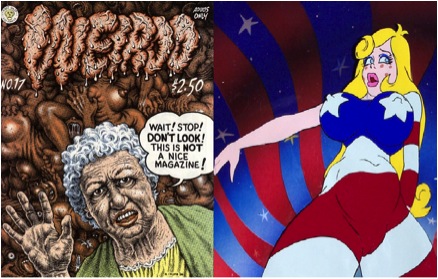
The mix of race, sexuality and culture in Underground Comix and Animation was rarely a comfortable one.
And what of his most recent film, you may ask, the one mentioned at the beginning of the article? Its title is Last Days of Coney Island, and it promises to have everything you’ve come to know and love from Bakshi; the underside of New York, prostitutes, gangsters, seedy character designs that younger audiences might mistake for Ren and Stimpy characters, and more. There’s something almost tragic to see the man who once produced more bombast (and on occasion, genuine artistry) than any other cartoonist this side of the Pacific working with a set of motifs that haven’t been relevant since the 80s. But such an assessment is enormously unfair to Bakshi; at 74 years old, he’s earned the right to work on personal projects, to conceptualize and illustrate his experiences as an individual rather than as an artistic rabble-rouser. But where Bakshi himself may not have succeeded, the need for a Bakshi-like manifesto remains for animation, for the fact remains that there simply isn’t anyone in contemporary American animation that is doing the type of political bomb throwing he did. That’s not to say that there isn’t excellent work being done by underground artists and animators in the United States, for their certainly is, but little of it has had the scope and reach of movies like Fritz and Heavy Traffic in their heyday. This can partially be attributed to changes in the animation industry in the whole as well as to changes in the political composition of underground artists that have made it refreshingly more queer, PoC and female-friendly, but any attempt at synthesizing the techniques, outlooks and technologies developed since the ‘70s has been minimal.
Ultimately, I would predict many of Bakshi’s films as individual works will be forgotten. Their racism, their misogyny, their formless anger and hatred makes them politically “incorrect” but more importantly politically conservative, reactionary and morally reprehensible. Aesthetically, they have not aged well with time, and their ultimate artistic value for many may simply be as relics of a long-forgotten counterculture movement and its sensibilities. But the need for a political Bakshism, and for the opportunities Bakshi’s animation studio created, will remain. In the years since Bakshi’s semi-retirement, animation has become increasingly complacent, animators increasingly maligned and mistreated by their production companies, and with the exception of more amateur creations produced through online collaboration, the medium itself has been increasingly displaced by more technologically advanced live-action works. In order to develop critically as a medium and retain clout in the way comics, and increasingly video games, have, animation needs more Bakshism, more rabble-rousing and anger and impetuses to collaborate, to subvert, and to pursue “adult” themes and narratives without needing to dress them up in kid-friendly formats. What it does not need is Bakshi’s racism, sexism or the general immaturity that colored so much of the Underground Comix movement of the time. Even if we forget Bakshi, we cannot, and should not, forget the movement that he struggled for, a movement both towards subverting American culture and media and redefining the parameters, depth, and meaning of animation itself.

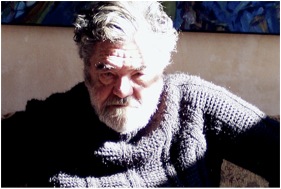
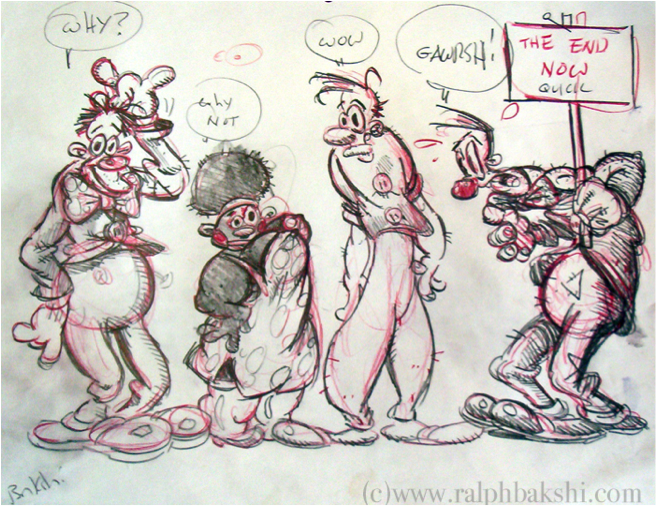
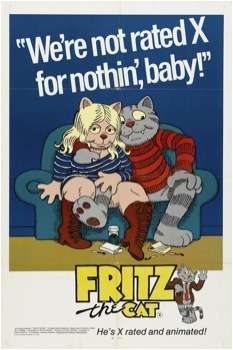
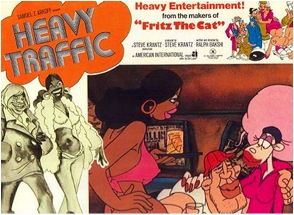
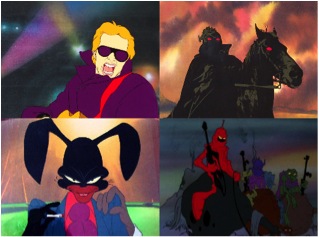
A really fascinating and really fair piece. Thanks Patrick.
I think the animation industry is in a similar kind of paralysis as many of the arts. It’s hard to be subversive when subversion is demanded by the markets, and culturally neutralized. There are few, if any, visual directions left to go in. But I think there’s a lot of hope for animation, as subversive narrative is far from exhausted, and its becoming easier and easier for individuals to learn how to animate.
Thanks so much Kailyn!
I definitely agree with your point on subversion being culturally neutralized when it’s in demand. As for visual directions, I’m a huge fan of the way that the recent film The Secret of Kells utilized traditional Irish art and formed an entire aesthetic around it, and I think drawing from historical art movements and styles could end up providing a lot of artistic and narrative direction for animators today.
The quickest way to be genuinely subversive, in the sense of having the state take notice and come after you, is to violate copyright laws.
Noah, that post was so on point I laughed when I read it. I don’t think there’s much “subversive” about pulling from a cultural history. The market LOVES stuff that can be traced to a locality! Nostalgia always sells. Especially when it’s someone else’s nostalgia.
On a more constructive note, a thorough and well constructed piece. I remember seeing Wizards as a kid and being totally disoriented by the tone.
I wouldn’t describe American Pop as “Heavy Traffic-esque” in the slightest. Hey Good Lookin’, yes. American Pop? No.
I’ve always thought that American Pop was the one film where Bakshi seemed to almost get it right, but then still managed to fail spectacularly, as he so often did. Unlike his version of LOTR or Fire and Ice (yikes!), the rotoscoping actually seemed to serve the material well and the use of archival footage (Hendrix, the Nicholas Brothers, etc.) was particularly effective. The basic idea of doing a history of American pop music through a family saga is certainly intriguing and parts of it are genuinely great, if occasionally heavy-handed. But a lot of it just doesn’t work at all (particularly once we get to the sixties and seventies) and the final segment of the film, where the coke-dealing Lou Reed (glam era) lookalike wows a bunch of jaded record producers and musicians with his rendition of Bob Seger’s “Night Moves” (after threatening to withhold his goodies) and immediately ascends to rock superstardom has to be one of the most head-scratching moments in movie history. I saw the movie when it came out (I was a huge Bakshi fanboy in my youth) and it was honestly one of the poorest audience reactions to a movie ending I think I’ve ever witnessed.
Why is no one talking about Wizards? It’s the closest thing to a good movie Ralph Bakshi ever made, and one where the rotoscoping is totally vital to both the plot and themes of the film. (Well, maybe American Pop does this too, but I’ve never been able to finish that snoozefest).
This a great and fairminded evaluation of his work, so thanks, Patrick for writing it and in particular getting at the tension between what’s exciting about Bakshi’s work (the intent and the aesthetics of his rotoscoping) and what’s terrible (The actual execution and all its attendant racism, misogyny and, often, dullness.) The good parts of Bakshi live on in Richard Linklater’s two animated films, I feel.
“The good parts of Bakshi live on in Richard Linklater’s two animated films, I feel.”
Which is quite an insult, since the one Richard Linklater animated feature I saw was an absolute and complete piece of shit. Maybe slightly better than Schindler’s List, but also maybe not.
Literally speechless with rage right now. “Waking Life” and “A Scanner Darkly” are both great.
Oh, wait. I saw them both; Waking Life and A Scanner Darkly. Those were both horrible, horrible, pretentious, ham-fisted slogs. I guess I hate A Scanner Darkly slightly more since I have affection for the book.
Why people like, or tolerate, or fail to spit every time they hear the name of Richard Linklater is something I’ve never figured out.
Okay, let’s talk about Wizards.
Wizards was the first Ralph Bakshi movie I ever saw and when I did, I was absolutely blown away by it for all the reasons you mentioned and more. For several years after that, I was completely obsessed with it (I’m fairly certain that I saw every single theatrical showing of it in the Boston/Cambridge area between about 1978 and 1983 in those pre-home video days) and if you’d asked me back then, I’d probably have placed it among my top 5 animated films of all time.
But somewhere along the lines, my opinion of the movie shifted.
Before I discuss how I eventually soured on it, let me mention some of the things that I still love: I agree completely that the use of rotoscoping is entirely appropriate, given the key plot point being the evil wizard Blackwolf’s use of films of the Nuremberg rallies to inspire his mutant hordes. And in general, Bakshi’s use of historical footage and other source material (most notably Eisenstein’s Alexander Nevsky) heavily tinted and occasionally enhanced with traditional animation gives the film a unique, hallucinatory quality. I also loved the incredible backgrounds and design work by Ian Miller and Ira Turek (among others) and best of all, the framing illustrations by Mike Ploog. Andrew Belling’s prog rock-ish score also holds up rather nicely.
But somewhere along the lines, certain things about it began to really bother me. First and foremost was the blatant ripping off of the work of Vaughn Bode both in specifics (Nekron 99 is quite precisely Bode’s Cobalt 60 in design and mood) and this uncredited appropriation really bothered me after a while. I also began to be bugged by the ending (which seemed to entirely undermine the “technology vs. magic” theme that was so important to the basic concept) and what seemed like an overall half-assed quality to the plot and storyline.
There are many individual sequences (e.g. the hilarious “They killed Fritz!” bit, or the hoboes reenacting the crucifixion) that still hold up. And even with all of its ripped-off ideas, it’s still very much Bakshi’s particular vision; but ultimately, as with every single other film he made, it seems like he got bored with the concept half way through and couldn’t really decide what kind of movie he wanted to make. His films always seem to start off strongly but then lose their way and eventually veer off into pointlessness and incoherence.
Thank you very much for this, Patrick. I know little about Bakshi, yet of all it meshes with what you describe. I may have to seek out Wizards now.
You might not have Seth MacFarlane, who is sort of a fascist shithead (as opposed to Linklater, who is just a hack) without Ralph Bakshi, who also raised good questions and offered bad answers. So I appreciate this article, and Bakshi’s existence.
“Ralph Bakshi, who also raised good questions and offered bad answers.”
Bert, I feel like you’ve summarized my own article better than I ever could!
The only Linklater I’ve seen is Slackers, which I thought was a delightful time capsule of a time and place. Makes me wish someone had done/would do the same for my beloved Birmingham, Alabama. Anyway, this article and comment thread are pretty terrific. There’s a coffee table book about Bakshi that I borrowed from the library… it’s well worth a look.
Bert, what do you see as the link between Bakshi and MacFarlane? I can see some (surface) similarities in work, but you seem to have something more concrete formulated and I’d be very interested to hear it.
They’re definitely parallels that may share another origin (like Western culture or something)– and the “missing link” is of course South Park and the Simpsons- but I just think MacFarlane’s deep desire to shit on feminists and harp on racial stereotypes has something in common with his clear cultural nostalgia– for musical theater, Anne Murray, Three Stooges slapstick, etc.
Sorry, got interrupted– but that nostalgia, I think, includes Bakshi, and is shared with Bakshi.
I think you’re on the right track Bert. MacFarlane and FG (which is completely awful) are simply the latest links in a chain that includes Bakshi, Wait Till Your Father Gets Home (look it up) The Simpsons, South Park, etc. MacFarlane is presumably aware of this, but I don’t see a lot of direct Bakshi influence. Also I think MacFarlane just likes pushing buttons with his racism, whereas Bakshi was actually trying to make some sort of statement, however muddled.
Oh, I’m quite sure MacFarlane thinks he’s making a statement. He’s funny sometimes even– like they cut to a classroom scene and the teacher says something like “So, what Orwell was basically saying was ‘If you can’t beat ’em, join ’em,'” Or something similar.
His episode with Brian (the dog) tripping on mushrooms seems the most obviously underground-influenced, for obvious reasons.
My 2 cents: McFarlane is a fascist and alongside Butch Hartman the bête noire of animation
Thanks for writing this! Bakshi is a case worth discussing fairly, but may I push back on this point?
IDK, I take issue with the slight romantic miasma surrounding the 60s counterculture, particularly the assaultive style of throwing offensive material in the face of a supposedly stilted mainstream. First of all, deciding for yourself that the parameters of someone else’s comfort zone must be violated for their (or society’s, whatev) own good strikes me as fascistic an impulse than the one that feels embarrassed about sex and compels others to feel the same. and besides, the square mainstream usually finds such outbursts titillating. I’m trying to understand why the tactic is important when very little socially constructive material actually came from it.
Is it a kind of insecurity that brings about the curious expression “masters of the Underground Comix?” The 60s comix underground was totally lousy, but for some reason we have to convince ourselves it was important because we don’t want to look around for “the best things going on in Comics at the time” and wind up with corny old Spider Man? As uncomfortable as I am thinking about Robert Crumb as a master in my field, maybe?
Thank you for the comment Michael! I’m not sure what you mean by “fascistic” in the context of pushing boundaries. Violating someone’s sense of safety and well being is certainly abhorrent, but I see that tendency within comix underground as representing something more puerile and self-destructive than fascistic, which implies a certain degree of maintained authority and aesthetic standards. At their worst (and they’re usually somewhere around their worst), UC artists were whiny, immature manchildren who didn’t want their toys taken away or their precious “art” criticized for whatever reasons.
I think the reason most of what came out of that movement is “totally lousy” comes from the naive idea that making people uncomfortable by being shrill and incoherent and perverse is a revolutionary activity. This is what leads to the unabashed racism, sexism, etc. in underground comix, which mistake cynicism and vulgarity as “accurate” depictions of reality (which in turn is seen as titillating by mainstream conventions). But in depicting the complex material conditions of working class, marginalized and otherwise outsider communities (a category I would not count most UC artists, themselves white, middle class, straight and male, as part of), artists like Bakshi were making the suits uncomfortable in a genuinely political way. Anger and chaos may not always be socially constructive, but they’re powerful weapons, especially when expressed in art. The distinction exists in determining who the target of such ire is; is it the conditions, institutions and powers that be that perpetuate inequality, or every little thing that makes the artist pissy? UC artists usually decides it was the latter.
I’d still argue that offensiveness and throwing things in someones face can be useful and constructive. Not an offensiveness that makes vulnerable people its target (because really, what’s the use in that? what’s the use in making who feel vulnerable, threatened and harassed every day for who they are feel even more vulnerable, threatened and harassed?) but an offensiveness that doesn’t feel the need to deal in useless pleasantries when throwing its bombs. Those kinds of tactics can radically alter the way one thinks about a given system of aesthetics or politics, and ultimately change their outlook for the better. And it’s for that idea of subversiveness that the “idea” of the Underground Comix movement appeals to me, but the movement itself ultimately took on quite a different shape. I don’t think of engaging the theory-practice of the Underground Comix movement as an act of romanticization so much as spelunking, finding out what’s theoretically useful about a given movement and what can be left behind. That being said, such a job is probably better suited for someone more versed in comics than I. I’m most as home watching stupid animal cartoons, personally.
PS I agree that the word “masters” is ill suited. I meant it in a more “predecessor” sense than a reverent one – perhaps “grandfathers” or “cranky white men” would be more accurate?
Michael, I shared your comment on the “Shut Up” thread, just FYI, since it really expressed what I was trying to say about white people trying to deal with their guilt by making fun of it.
Pingback: Forgetting Bakshi | ??????
While I agree that no current subversive animators have the same soapbox Bakshi had, they are nonetheless out there. My personal favorite is Nick Cross. His films PERHELION, YELLOW CAKE and THE PIG FARMER are in your face, harsh mini masterpieces, IMO.
His series “pilot” for “Angora Napkin,” though, I do not like. It veers away from these other films into Krisfalusian territory with its portrayal of its female protagonists.
Didnt Wu-Tang Clan try to get Coonskin remade? I’ve never seen it but I find it interesting that it has some rapper fanbase.
I’d love to see animation have a renaissance. Preferably in the style of the best russian animation, but they chances of anyone funding or getting enough people to watch it are depressingly slim.
As interesting as the Bakshi/Underground Comix discussion is, I’m curious about Noah’s hate for Richard Linklater. I actually like him quite a bit, for the most part, although I do acknowledge that he can be kind of pretentious, so if you’re not into amateur philosophizing, you won’t enjoy Slacker, or Waking Life, or whatever. I love Waking Life (although I haven’t seen it in a few years, so maybe my opinion would change if I revisit it), but mostly for the lovely animation and the Austin setting. A Scanner Darkly wasn’t great, but I didn’t think it shit all over the book or anything, and it had some nice visuals, like the representation of the Scramble Suit.
I really don’t get the portrayal of him as a hack, since he tends to make very personal movies that fit his own particular style. The Before Sunrise/Sunset/Midnight trilogy (I haven’t seen the latest one yet, but I’m looking forward to it) is a lovely series of conversations between characters that stretches across decades. Bernie is a fascinating look at a real-life murder, with a great performance by Jack Black. Fast Food Nation might not have been great, but it was a valiant attempt to adapt a non-fiction book by taking an Altman-esque approach to all levels of its subject matter. Even his more crowd-pleasing stuff like Dazed and Confused or The School of Rock has his own sense of playfulness. You might not like that style, but he’s far from a soulless hack just cranking out work-for-hire Hollywood junk.
In conclusion, I like Linklater a lot, and I definitely do not spit when I hear his name. Take that, Noah!
I don’t think he’s a soulless hack. I just think he’s awful.
Or at least often awful. Slacker and Dazed and Confused were okay. I really hated Waking Life though.
I guess I should see Before Sunrise. It looks eye-gougingly awful, but I know everyone loves it. Maybe it would sway me.
I really doubt that you would like Before Sunrise. It’s pretty typical Linklater, with Ethan Hawke and Julie Delpy walking around and talking about their personal philosophies. Their insufferability can be explained away as the pretentiousness of youth though, if you want, and I do like the development of their relationship. Before Sunset might be better, with them reconnecting several years later as people with more adult concerns, and I’ve heard Before Midnight adds even more, looking at their relationship after they’ve been together for several more years. I dig it, but I would be very surprised if you feel at all positive about it, considering your dislike of Linklater.
I never saw Fritz, nor do I want to. I liked some aspects of the largely offensive Coonskin and Hey Good Lookin’ but American Pop and Cool World, just yuck. Fire & Ice at least had the benefit of Frazetta’s hands-on involvement, but the bad taste that always sticks in my mouth about Bakshi is from the ripoffs of Vaughn Bode and Wally Wood for Wizards.
Bakshi is brilliant. Period. He was able to accomplish the impossible – and didn’t stop half way. However his work is interpreted…. He did IT. Which no one had before – or since. He had the tenacity, the courage, and the drive to keep going when everyone said he couldn’t. He is an amazing artist…. And will never be forgotten.